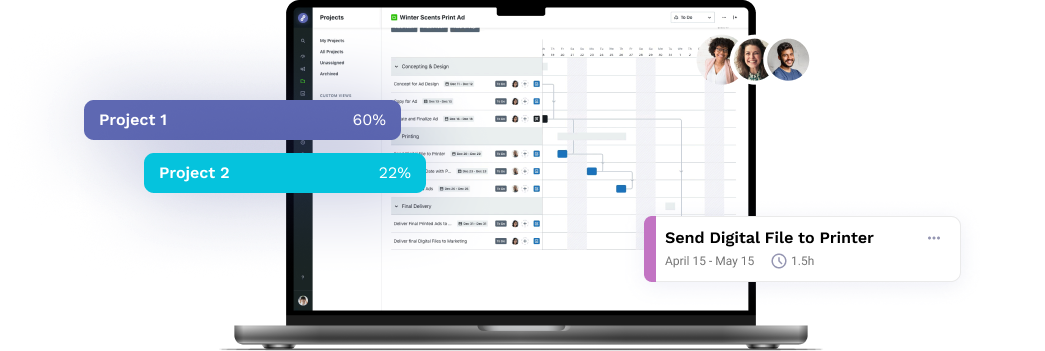What Is Digital Content Management?
September 6, 2022 Share this article

Digital Content Management, also known as digital creative lifecycle management, is a mouthful! To put it simply, it refers to the strategic management of your content’s life, including any images, visuals, text files, videos, and more. But what exactly do we mean by ‘life’ for content? A piece of content begins its life even before it exists, when it is still in the conceptual and development stages. Then it is created, published and active in the market for some period, years, but only months. Its life ends when it is archived or updated into a new piece of content.
Digital Content Management Benefits
Part of managing your digital content is considering what content you need, who is going to create it, and where you will use it. This is essential because in today’s business, there is an insatiable appetite for new content. However, nailing the entire plan requires time and effort to make sure you manage your digital content as effectively and efficiently as possible. To effectively manage your digital content, you will need a Digital Asset Manager (DAM). With resources always limited, you might wonder, is this beneficial? Could you be doing something better with your time?
In fact, this planning process is critical to maximizing the efficiency of your time. You deplete your resources when you spend time creating content that does not have a clear purpose, or when you fail to identify existing content, you can use it for a new campaign. The benefits of an effective digital content management plan extend beyond the marketing team. Sales, customer experience, and the brand overall will benefit from better management of your digital content.
Benefits for Marketing
As we all know, marketing is a big content consumer. Marketers have increasing workloads as content demands increase. They are the team that plans, creates, and distributes digital assets through multiple channels – campaigns, events, emails, websites, and more. So, it is unsurprising that marketers are also the ones pushing for consistent content management practices.
Content management is involved in most areas of marketing: knowing what to create, whose approval is needed, and where everything gets stored after a campaign is over. Having a well-designed and well-executed digital content management plan ensures that the content marketing team functions seamlessly.

Review & Collaboration
Having a process for review and collaboration will ensure your creative content addresses its purpose, preventing your marketing team from having to recreate content that does not hit the spot.
Manage & Share
Eliminate lost or misplaced digital content by consolidating and centralizing content into a sole source. If you know where you have stored your assets, your marketing team never has to recreate them – saving them time and their sanity.
Distribution & Measurement
Once content is ready to go to market it is critical that it is distributed strategically and in a way that enables measurement of the content’s performance. Your marketing team should be able to measure the performance of content against the desired outcomes, and then match that back to the creative level of effort to understand ROI. Tracking metrics that show the efficacy of creative content gives your creative team the insights you need to continuously improve.
Benefits for Sales
Sales and revenue teams also rely on content to engage new leads and close deals. They are always on a time crunch. As the saying goes, ‘time kills all deals.’ This means that sales teams need to be able to access the right content, quickly. This is where proper management of your content comes into play. Having a process in place for creating, storing, sharing, and accessing digital assets means sales teams can focus on what they do best- wooing the prospect and closing deals.
Benefits for Customer Support
The customer’s interaction with content does not end when they sign the contract. After the deal is done, the customer goes over to the customer experience team. These teams need content to successfully onboard, implement, and attend to customer queries.
Managing your digital content prevents duplication, old versions, and time wasted in finding the right digital assets. It ensures a consistent experience. And of course, this leads to customer retention- which is always the goal.
Benefits for your Brand
As we have discussed, managing your digital content is beneficial to all teams. But beyond looking at a human level, let us look at your brand. The foundation of your brand image rests on the successful execution of your content program.
For your brand to stand out, you must present a consistent brand image. You want people to see the same logo, hear the same tone-of-voice, and see similar visuals and messaging. Managing your content effectively and efficiently is your vehicle for consistency. It ensures content is created for a purpose and designed according to your brand guidelines. Consistency makes your brand memorable, which improves your chances of success.
Content is essential – without it, your teams would not be able to do their jobs effectively and efficiently. So, knowing the importance of content itself, it is easy to see why managing your digital content is just as important. You want to give each team the tools they need to soar and having a digital content management plan is what you need.
Recommended reading: The Future of Digital Asset Management
Lytho helps you streamline your entire workflow and harmonize all brand collateral under a single, uniform platform. Feel free to reach out to us by scheduling a demo and learning how our creative solutions can boost the effectiveness of your creative projects. We look forward to speaking with you!
Do you want to give yourself and your creative team more room for creative stimulation by automating the boring stuff? Lytho helps you streamline your entire workflow and harmonize all brand collateral under a single, uniform platform. Feel free to reach out to us by scheduling a demo and learning how our creative solutions can boost the effectiveness of your creative projects. We look forward to speaking with you!

Ready to simplify your creative operations and start having a little fun at work again?
Schedule time to talk with us.
Let us show you how Lytho’s Creative Operations Platform helps in-house creative and marketing teams do better work, ease the stakeholder experience, and stay on brand.
Schedule a Demo